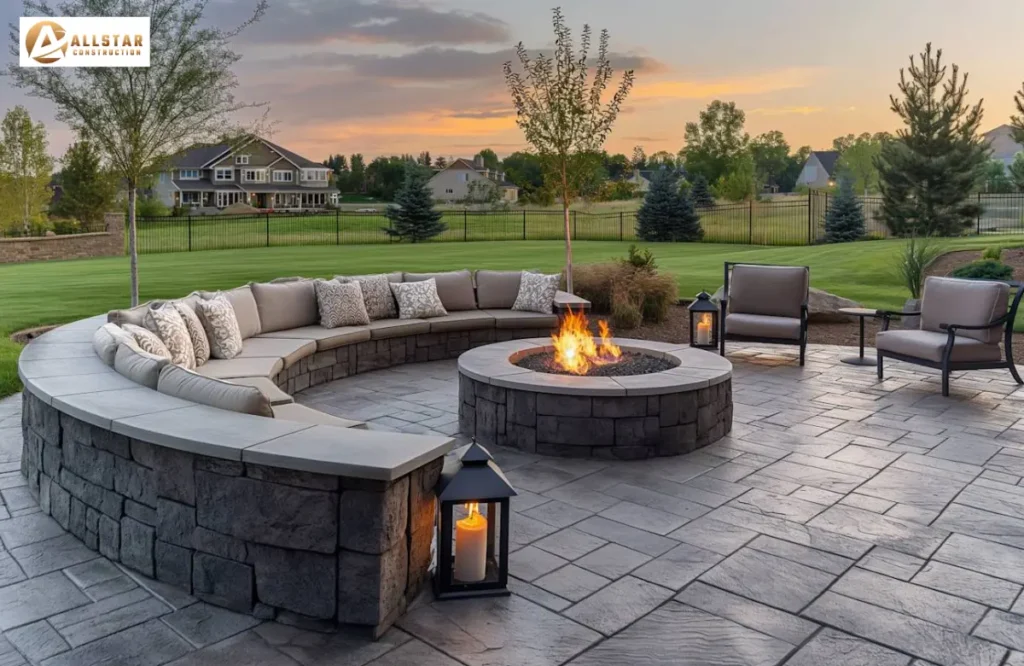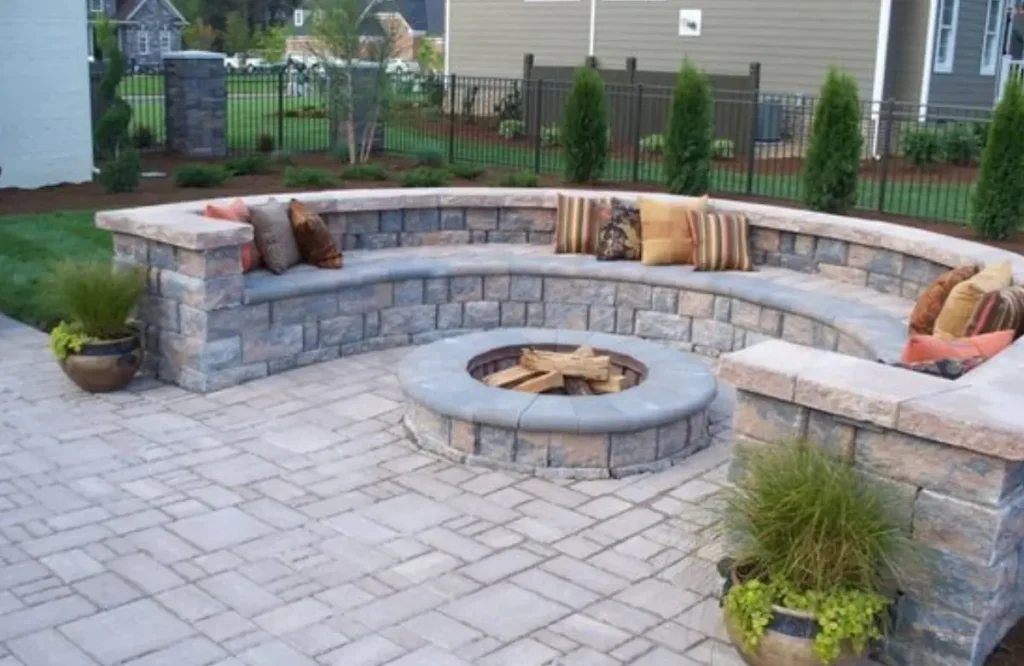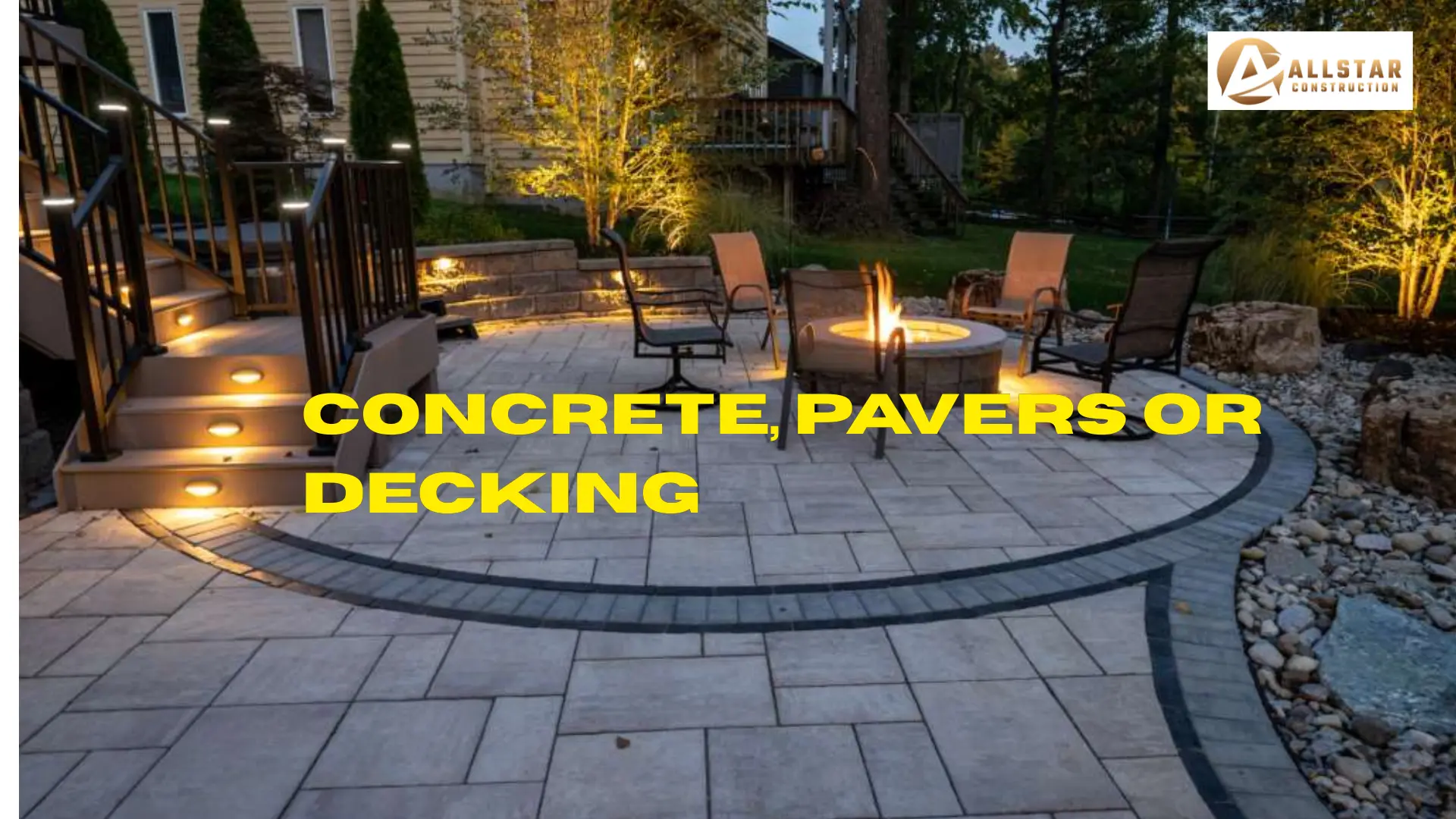You eat, relax and spend time outside on your patio. The correct choice of the base prolongs and improves the working process of space. The type of base you use influences the appearance of the patio, the amount of work required, and the safety of the patio.
This guide will assist you in comparing concrete, pavers as well as decking. You will find out which one shines in what issue and what issues to be prepared to and what to choose to make the best decision in regard to your yard.
Aesthetic, functional, and budget considerations
Consider how you would like your patio to appear. Another thing to consider is how you will utilize it, and how much you can afford. There are other options which are cheap initially but later more expensive to repair.
How your choice affects long-term durability and maintenance
An excellent foundation reduces maintenance. There are those materials that require sealing or leveling. Other ones require minimal maintenance but are more expensive to set up.
- Concrete: Simple and modern. Good for flat spaces. Can crack in cold weather.
- Pavers: Flexible and decorative. Easy to repair one piece at a time.
- Decking: Elevates your space. Slope friendly but require more maintenance (wood) or just cost more (composite).
Why Choosing the Right Patio Base Matters
Selecting an inappropriate base may result in sinking, cracks, weeds or ineffective drainage. Good furniture foundations ensure that furniture does not tip over and provides a safe environment to family and friends. It influences the duration of the patio as well.
An excellent foundation can save in the long run. It also simplifies upgrades in the future. An example would have running wiring or a hot tub that is easier with the appropriate base.
Where Each Option Works Best
- Concrete can be used on level ground and simple, contemporary designs. It works best on large surfaces such as driveways or large patios.
- Pavers are suitable in areas of heavy traffic and where patterns and color are required. They are appropriate in the small slope yards.
- Decking is the way to sloped yard or where you need to raise it or desire the warm wood appearance. 2nd story decks and rooftop patios also fit well.
Choosing the Best Patio Base: In-Depth Guide
A decision regarding a patio base implies adapting the material to your yard, your climate, use, and your budget. A comprehensive, easy to read, guide is given below to assist you in selecting and knowing what each option will cost to install and maintain.
Understand the site and soil first
Start by looking at your yard. Is the ground flat or sloped? Does the water drain or stand in areas? What kind of soil do you have- rocky, sandy or clay? Clay contains water and is able to move with frost. Sandy or rocky soil is stable and well drained. These facts alter which base is going to work best.
In the event that your yard is slanting, decking can be more convenient than levelling of concrete. In the case of poor soil, there might be the need to excavate more and provide concrete or paver base layer.

Load and use matter
Ask how you will use the patio. Will you place a heavy hot tub or fire pit on it? The bulky ones require a heavy base. Concrete is extremely solid and has the capacity to support lots of weight. When the base is also compacted, pavers are also able to deal with weight. Heavy loads can be taken on decks, however the frame and footings should be built to code.
Exception Placing Grill and furniture If you intend to entertain a crowd, or place a grill and furnishings, plan the base of these loads.
Drainage and water flow
Water control is vital. Lack of proper drainage may displace the soil thus sinking or cracking. Pavers do not seal off the joints and are permeable with gravel base that is helpful. The concrete should have slope and drainage channels which need to be correctly laid. The decks are raised above the ground therefore the water is flowing below the surface and is not standing on the surface.
During rainy or freeze-thaw seasons, drainage and an effective base layer (gravel, compacted sand) is essential.
Climate and freeze-thaw cycles
Unless there is good base and joints, concrete can crack in case you live in a place where it freezes. Pavers can be somewhat mobile and they are not difficult to repair in case frost heaving occurs. In cold climates a decking is a good option, as it does not rest on the earth in the same way. Rotting of wood may however occur when the supports are not adequately treated and kept dry.
Installation steps and base prep
To begin with making a good base, one has to dig to the correct depth and layer it:
- Dig soil to a constant depth.
- Compacted gravel or crushed stone should be added in order to form a robust foundation. This layer helps drainage.
- In the case of concrete, a compacted base should be added and a reinforcement rebar should be poured in case it is necessary. Provide expansion joints in order to curb cracks.
- In the case of pavers, add layer of packed gravel, and the paver bedding packed with sand. Apply edge restraints to keep pavers in place.
- In decking, the concrete footings are placed at a location below the frost. Assemble the frame, and fit boards or composite planks.
Each step must be done right. Lack of compaction or correct slope results in future problems.
Costs and life span
- Concrete: A medium initial price. Long life (20+ years) when installed and maintained. In case of big cracks, repairs are expensive.
- Pavers: Expensive initial expense and work. Easy and very long life repair. Replacement of individual pavers is possible.
- Decking: Varies, wood is less expensive initially, requires to be sealed and maintained. Composite is more expensive, and requires less maintenance, potentially lasting 25+ years.
Consider total cost installation and maintenance- in 10-20 years.
Appearance and design
Concrete offers a clean look. Stamping or coloring of different textures is possible. Pavers offer the greatest freedom of design pattern, colour and shape. The decking is natural and warm. Composite decking is available in a wide variety of colors and requires less maintenance.
Repairs and tweaks
Pavers are easiest to repair. In case of cracking of one of the pavers then lift and change it. Patching or resurfacing often must be involved in concrete repairs. Deck boards can be easily replaced in case of rot or warp but structural framing is more difficult.
Accessibility and code
Search local building codes and permits. Footings and railing permit and inspection of decks are usually required. Special patio footings and electric permits may be needed in hot tubs. Less review may be needed on concrete, paver projects, including drainage and setback requirements.
Environmental and site impacts
In its production, concrete has a huge carbon footprint. Pavers reduce the effects in the long term and permit certain recharge of groundwater. Wood decking is natural, however, requiring treatment that may contain chemicals. Composite is recycled in most instances and can be environment friendly.
Final decision tips
- In the event you prefer low-maintenance and toughness and your lawn is flat: concrete.
- Pavers are the way to go in case you desire design, simplicity in the repair, and proper drainage.
- When your lawn is sloping, or you wish to be raised up: decking.
Consider long term plans too. In case you will include a hot tub in future, intend to have a strong base or reinforced concrete.
Option 1 – Concrete Patios
Pros of Concrete
- Affordable and widely available.
- Clean, modern look.
- Low maintenance and easy to hose down.
Cons of Concrete
- Prone to cracking in freeze-thaw cycles.
- Less flexible in design.
- Can be hot underfoot in direct sun.
Best Uses for Concrete
- Minimalist or modern backyard designs.
- Large, flat surfaces with low foot traffic.
- Driveways and areas that need a solid, even base.
Option 2 – Paver Patios
Pros of Pavers
- Excellent drainage and flexibility.
- Highly customizable in shape, color, and pattern.
- Easy to repair (just replace individual stones).
Cons of Pavers
- Higher upfront cost and labor-intensive installation.
- Weeds and ants may find their way through joints.
- Requires occasional re-leveling and sanding.
Best Uses for Pavers
- High-traffic areas or intricate designs.
- Traditional, European, or cottage-style landscapes.
- Walkways, patios with patterns, and pool surrounds.

Option 3 – Decking (Wood or Composite)
Pros of Decking
- Elevated surfaces work well on uneven terrain.
- Warm, natural appearance (especially with wood).
- Great for multi-level or tiered patios.
Cons of Decking
- Wood requires sealing and maintenance.
- Composite is low-maintenance but more expensive.
- Not ideal for open fire pits unless rated safe.
Best Uses for Decking
- Sloped backyards or areas with drainage issues.
- Outdoor lounging, poolside areas, or second-story patios.
- Spaces where you want a warm, wood-like feel.
Key Factors to Consider When Choosing a Patio Base
Your Climate and Weather Conditions
When there is a lot of frost or there is a wide variation in temperature, then prefer the materials that can move easily.
Ground Level and Soil Type
Soft or moist soils require improved base preparations. Slopes can be a quick solution of decking.
Intended Use (Dining, Fire Pit, Hot Tub, etc.)
Massive accessories such as hot tubs require strong and reinforced foundations.
Budget – Both Installation and Maintenance
Think long term. What is cheap now, may be expensive to fix in the future.
Aesthetic Goals and Landscape Design
Find the base to suit your home and garden. The most design choices are available with pavers.
Maintenance Comparison
Cleaning Frequency and Techniques
- Concrete: Sweep and pressure wash. Seal every few years.
- Pavers: Sweep, pour joint sand over, replace pavers when necessary.
- Decking: Sweep, wash, stain or seal wood every 1-3 years; composite requires it less.
Seasonal Upkeep
Patching of the concrete in cold climates might be required. Pavers require joint sand filler. Wood decks should be checked to see how far they are rotted.
Long-Term Repairs and Replacement Costs
Spots are most readily and inexpensively repaired using pavers. The cost of maintaining concrete repair can be expensive. Board or joists replacement can be required with time.
Conclusion
Select concrete when you desire a polished appearance, durable surface and a reduced initial price of flat yards. Choose pavers when you want pattern /easy local repair and good drainage.Choose decking when you need a sloping yard, or when you want a raised surface or when you want to feel the warmth of wood.
Every yard is different. A professional is able to check soil, slope and flow of water. They will assist you in selecting the most appropriate long term base. We can help you with your patio project, or get expert guidance as to the best base to use in your yard.
To explore more patio ideas and get professional guidance, visit All Star Construction Group.
FAQs
Concrete can generally be the least expensive to pour, though and labor as well as site preparation are a consideration.
The best pavers and composite decking would take a long time to maintain with low maintenance.
Hot tubs require a strengthened bottom. Concrete is safest. With a well compacted base, pavers may be employed. Decks should be engineered supported.
Weeds can grow in joints. Weeds are decreased by proper joint sand and sealing.
Cures within a few days but requires time to is strengthened. Pavers take longer to lay. Decks rely on frame and design–they are usually longer.


